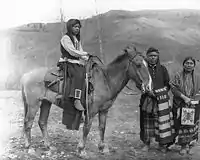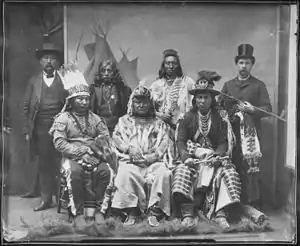Palouse people
The Palouse /pəˈluːs/ are a Sahaptin tribe recognized in the Treaty of 1855 with the United States along with the Yakama. It was negotiated at the 1855 Walla Walla Council. A variant spelling is Palus. Today they are enrolled in the federally recognized Confederated Tribes and Bands of the Yakama Nation and some are also represented by the Colville Confederated Tribes.
 Palouse-Colville Family (1905) University of Washington Digital Collections | |
| Regions with significant populations | |
|---|---|
| Languages | |
| English, Salishan, Sahaptin | |
| Related ethnic groups | |
| Colville, Sanpoil, Nespelem, Sinixt, Wenatchi, Entiat, Methow, Southern Okanagan, Sinkiuse-Columbia, and the Nez Perce of Chief Joseph's band |
Ethnography
The people are one of the Sahaptin-speaking groups of Native Americans living on the Columbia Plateau in eastern Washington, northeastern Oregon, and North Central Idaho: these included the Nez Percé, Cayuse, Walla Walla, Umatilla and the Yakima.
The people of the region lived in three main groups, the Upper, Middle, and Lower bands. Traditional lands included areas around waterways such as the Columbia, Snake and Palouse rivers.
The ancestral people were nomadic, following food sources through the seasons. The Palus people gathered with other native peoples for activities such as food-gathering, hunting, fishing, feasting, trading, and celebrations that included dancing, sports and gambling. They lived near other groups including the Nez Perce, Wanapum, Walla Walla, Umatilla and Yakama peoples.
The people were expert horsemen. The term Appaloosa is probably a derivation of the term "Palouse horse." They bred the horses for their distinct markings. In the latter half of the nineteenth century, the United States Army captured and slaughtered hundreds of tribal horses to cripple the tribe during the Indian Wars.
History
In October 1805, Lewis and Clark met with the tribe, although most were away from the area for fall food-gathering and hunting. Lewis and Clark presented one of the expedition's silver peace medals to paramount Chief Kepowhan. The Diaries of the Corps of Discovery describe the people as a separate and distinct group from the Nez Percé.
After Kepowhan, during the decades 1830', 1840', 1850, Wattaiwattaihowlis (Kepowhan's son and probably principal chief), Kahlotus (known also as Quelaptip and Talatuche, chief of the Upper Palouse), Soei (chief of the Middle Palouse), Nehtalekin (called also Hahtalekin the Elder), Tilcoax (chief of the Lower Palouse), Hinmahtutekekaikt alias “James” (one among the first to be Christianized, friend to Henry H. Spalding and Marcus Whitman, often associated to the Nimiipu band of Hollolsotetote), were the leaders until the Isaac I. Stevens Treaty in 1855, when the Palouse refused to take part but sent, as observers, Kahlotus (already a good friend to Marcus Whitman), Tilcoax (a war chief) and Slyotze; "Old" Hathalekin and Tilcoax led the Palouse warriors against the U.S. troops during the Cayuse's uprising in 1847–1848, defeating col. Cornelius Gilliam and his "Oregon Volunteers" on the Tucannon Creek (March 14–15, 1848). In 1858 Tilcoax led again the Palouse warriors in the "Skitswish (Coeur d'Alene) War": in May 1858 the Palouses succeeded in taking possession of an herd of Army's horses, but, on September 8, 1858, their own herd of 800 horses was slaughtered by col. George Wright's soldiers, and they surrendered.
Husishusis Kute, chief of the Wawawai Palouse, and "Young" Hathalekin (also known as Taktsoukt Jlppilp), war-chief, led a small Palouse band as allies of the last free Nimiipu of Heinmot Tooyalaket alias "Chief Joseph"; "Young" Hathalekin died fighting on August 9, 1877 at Big Hole; Husishusis Kute surrendered with Heinmot Tooyalaket on October 5, 1877.
Notable Palouse
Palouse Chiefs
- Tilcoax ("Wolf Necklace") led the Palouse warriors during the Skitswish (Coeur d'Alene) war in 1858, fighting against Maj. Steptoe and Col. Wright troops.
- Husishusis Kute (Husis Husis Kute, Hush-hush-cute - “Bald Head”, “Naked Head”), was leader and tooat — Medicine man or Shaman, or Prophet — of the Wawawai Band. Its territory was along the Snake River below Lewiston, 50 miles up the Snake River from where the Palouse enters it.

- Hahtalekin (also known as Taktsoukt Jlppilp - “Echo” or “Red Echo”), chief of the Palus Band (or Palus proper), who lived at the confluence of the Snake and Palouse rivers. His band were all of the buffalo-hunter-class. During the flight with the Nez Perce, his following was made up of 16 men.
Bibliography
- Chalfant, Stuart A. (1974). Ethnohistorical reports on aboriginal land use and occupancy: Spokan Indians, Palus Indians, Columbia Salish, Wenatchi Salish. Garland Publishing. ISBN 0-8240-0782-4.
- Note: S. A. Chalfant's report was presented before the United States Indian Claims Commission as docket no. 161, 222, 224.
- Manring, Benjamin Franklin (1912). The conquest of the Coeur d'Alenes, Spokanes and Palouses: the expeditions of Colonels E.J. Steptoe and George Wright against the "northern Indians" in 1858. Inland Printing Company.
- Sprague, Roderick (1998). Handbook of North American Indians. Volume 12. Plateau. Smithsonian Institution. pp. 352–359. ISBN 0-16-049514-8.
- Trafzer, Clifford E., and Richard D. Scheuerman. (1986). Renegade Tribe: The Palouse Indians and the Invasion of the Inland Pacific Northwest. Washington State University Press. ISBN 0-87422-028-9.
- Wright, G., Col. (1858). Great battle of the Spokane plains, Washington Territory. Philadelphia Press.
- Note: One and a half columns of text published in the September 23, 1858 issue of The Press, Philadelphia. The newspaper story quotes dispatches sent by Col. G. Wright regarding an "expedition against Northern Indians, camp on the Spokane River, (W.T.), one and a half miles below the Falls, September 6, 1858."
See also
| Wikimedia Commons has media related to Palus. |